Darklands and the Black Art of Text
I've recently fallen into playing a bit of Darklands, as I do every few years. It's an ancient game and the usability is bad in so many ways DOS games were. These flaws are easy to demonstrate. What got me thinking here was the consideration of what it does right, particularly in terms of using of text as a part of interactive gameplay.
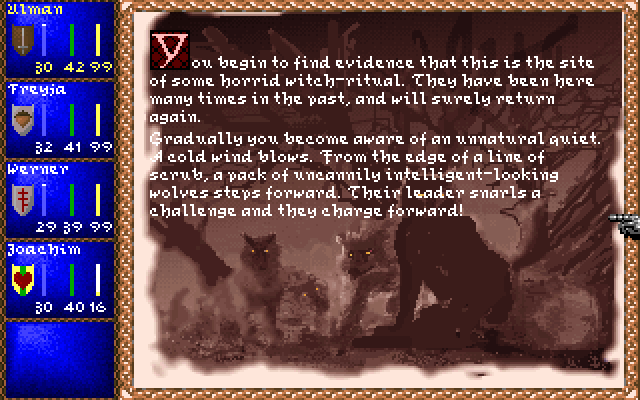
We should start with a quick overview of Darklands: Imagine a realtime pause-and-command combat RPG with a choose-your-own-adventure style interface and a free-roaming overworld map set in a fantastical version of medieval Germany where all of the folklore, myths, and medieval religion that people believed in is actually true. And it was made in 1992. Behold!
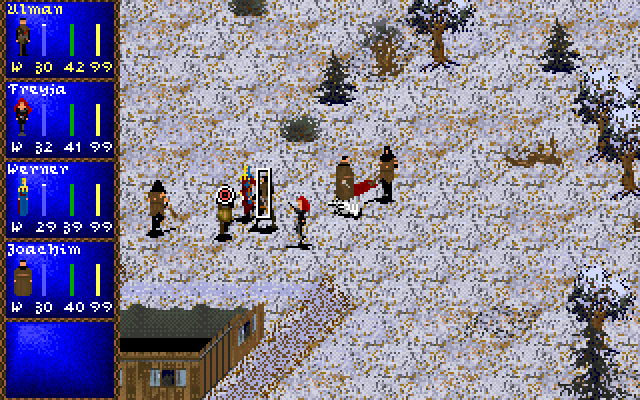
Darklands combat was far ahead of its time and the ideas it pioneered form the basis of many modern RPGs. This post isn't about the combat system however.
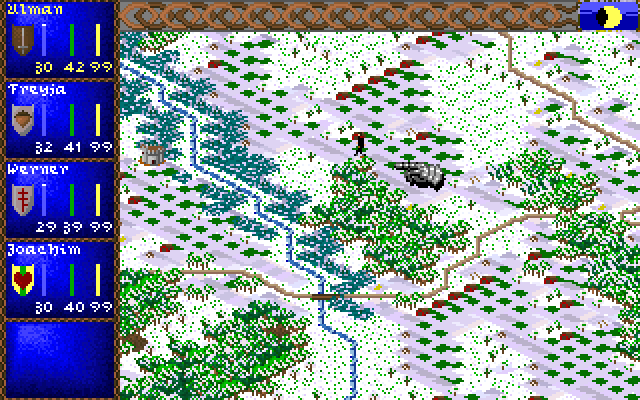
Here's the Darklands overworld! This post isn't about the Darklands overworld. It's pretty standard, but I quite enjoy the cute little towns and castles, and the turn of seasons.
So what's Darklands do so well in its use of text in its game world? Let's get into it.
Darklands uses text to navigate physical space.
This has several advantages. First: It's fast, it wastes none of the player's time. You can charm through the main gate of Köln with a charisma/speech check and find yourself on the main street in two clicks. Then where? The inn in one click, a market to sell your junk in two, the church in three, or you may find yourself taking on a quest for the Hanseatic League in four clicks if your reputation and charm is sufficient to impress their local outlet.
It's all very efficient, no waiting involved, no loading screens, no botched pathfinding, no having the navigate your little dudes around the same street again and again to sell Kobold Lint.
I need but say "You must gather your party before venturing forth" to recall these frustrations for those of you who have played (for example) the Baldur's Gate series. In Baldur's Gate you would have to navigate isometric space to ensure that each of your party members was within a minimum range of an exit zone before your party could leave the are and get on with the fun stuff. Given that game's occasional pathfinding failures and often narrow dungeon corridors – important for tactical combat – this was the source of much delay and frustration. Not that Darklands wholly escapes this pitfall because it does the exact same thing in its dungeon-crawls, but with even more limited pathfinding and crude user interaction schemes. Darklands even allows you to leave party members on separate submaps, which is universally a bad idea for the player and may lead to all manner of confusion.
... But that isn't the point, the point is the clarity of the choose-your-own adventure interface. Particularly for a small development budget, the question must be asked: What is the purpose of allowing a player to navigate a space? Is this where assets and content creation should be invested? What is the purpose of this space in terms of advancing what the game is about – is that purpose served by allowing a player to navigate the game-space in more mechanical dimensions than are ever used in that space? (Is the mechanically-accessible space overbroad simply to allow for a few special cases?) Which leads us to this:
Darklands uses text to navigate decision space.
In doing so, a player is given clear access to what important choices exist out of a set that could otherwise be unwieldy due to UI and simply overwhelming due to the large set of possible options in such an open world.
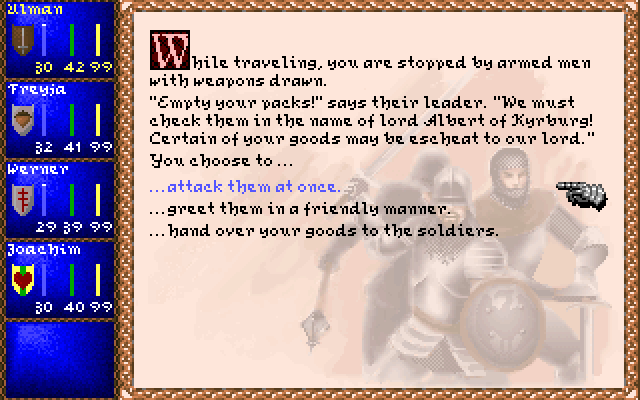
Albert of Kyrburg's guys got no chill.
Above is a fairly simply example of being waylaid by a Raubritter's thugs. Option one initiates combat, option two attempts a charm/speech check which, if successful, will result in avoiding the encounter, while option three of course gives up your loot and no one ever chooses it. Let's look at another such dialog:
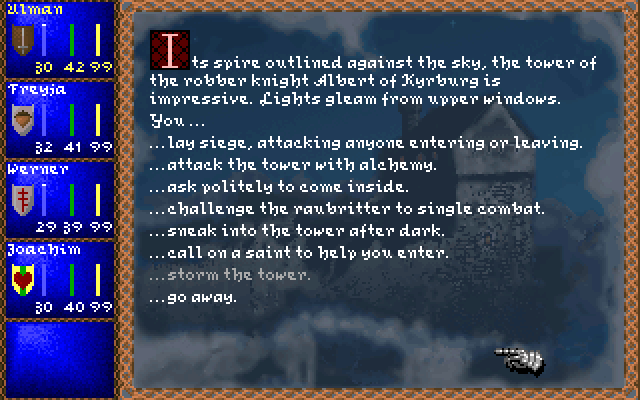
I'm just not sure about what a Paragon or Renegade would do in this situation.
Here we've advanced on the castle belonging to the Raubritter Albert of Kyrburg whereupon we are presented with a number of options. The text makes it clear what sort of character each approach favours, and selecting certain of them (using alchemy, calling upon a saint) will present a small contextual sub-menu letting you choose which potion or saint to use. Storming the tower is grayed out until you remove the gate by some means.
This method of interaction tells the player what options they can use in a situation very clearly, and what options may become available given certain other conditions being met. The inverted approach would be to present the situation without the solution-hooks then leave it up to the player to find and apply a skill or game-verb somehow to solve it. Whether this is the right choice depends on several factors. In a game with as many skills and systems in play as Darklands (and a rather poor UI for navigating inventory, and saints), making the player find the solution through the rest of the interface would very much be the wrong way to go about this. If this were a game with a limited set of player 'verbs' however, a more player-driven simulation/naturalistic approach could work.
Simulationist games are very much "in" these days, and current technology makes their creation much easier than before. It may be argued that they allow for a more immersive experience and enable a player to experience the setting more naturally. I do think one should bring up the question of focus, however, and I believe Darklands' use of text supports its deep, strange setting without requiring the player become overburdened with esoteric commands and knowledge.
(Actually, this isn't true at all: Darklands' other design peculiarities absolutely require the player become overburdened with esoteric commands and knowledge and you'd better have a map and FAQ open while playing it. But this isn't a fault of the text mechanics!)
Darklands uses text to give the player access to the setting.
Let me show an example what that means: The setting of Darklands is widely considered one of its strongest points. It sets itself apart from most RPGs, particularly of its time, by not placing itself in the tradition of Tolkein-esque D&D derivatives. There are no elves as-such, nor dwarves … as-such, but I won't spoil that. Instead, there are Raubritters, the Wild Hunt, Holzfrau, and the somewhat bizarre practices of this fantastic version of the medieval Catholic Church, simony and all. If you're not careful a bishop might curse you! How are you to know any of this?
Well, the text tells you. Most situations are explained in such a way that gives the German words context, hints at the effects of pissing off the clergy, and otherwise gives subtle info-dumps baked into the text describes locations and situations.
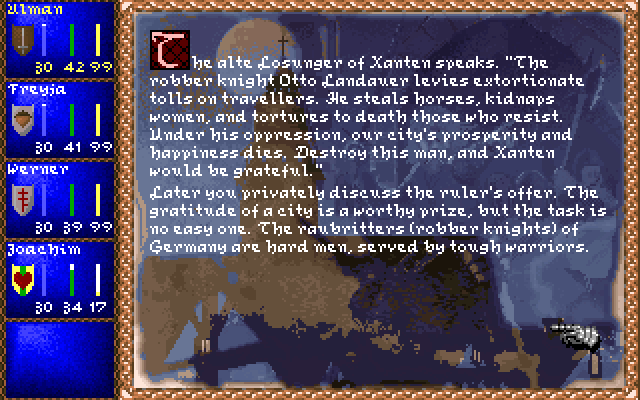
You're going to have to take my word for it that the previous scene made it clear what the heck an "alte Losunger" is.
While many of the mechanics are insufficiently explained and poorly balanced, to Darklands' credit there are very few blatant info-dumping scenes that are not a part of an action you initiated. The world is yours to explore! And, basically, the player is told what their characters would know. And your characters know how to navigate the social and mythological/religious setting of the world they inhabit (up to a point), so they are given descriptions and options appropriate to that knowledge. And all the while Darklands sets a very particular mood, and very economically, which brings us to the next point:
Darklands uses text to do aesthetic heavy-lifting.
The mood is set by a combination of the text itself, historically-accurate tunes played in charming early-90's midi style, and a set of generic water-colour backgrounds rendered in stunning 245x388 pixels.
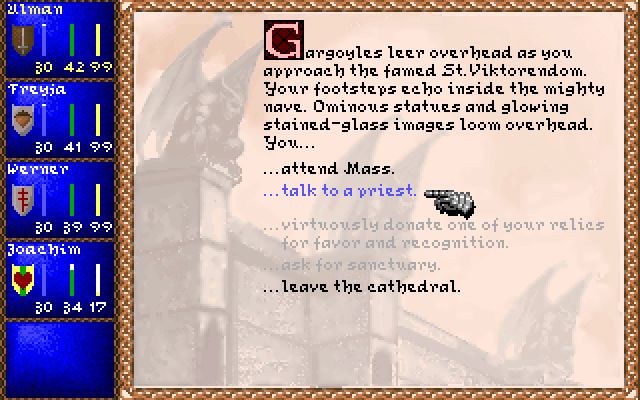
I bet you've got a pretty good guess at what donating a relic will give you.
Frankly, text is extremely cheap. It can be iterated extremely quickly. It's way easier to use one of a limited set of fairly generic backgrounds than it is to model or map a unique scene for every location. Simple string substitution lets you acknowledge qualities and choices the player has made easily. People love the feeling that they're part of a world and having an effect on that world! And if you don't have to budget to simulate the experience of visually being inside that world, the next best thing is to do it at a slight remove.
So while Darklands does a lot that's been done far better in the twenty-five years, it's still got some fine points of effective game design at work that may be useful for indie developers. Why stretch your resources to develop a game-space with obvious deficits and limitations when you can work with text? It's a highly constrained medium in a sense, but once a player buys into using text as a means to experience the game world, it only feels as constrained as you are able to 'sell' the dialog. Think of it as offloading your rendering to the player's brain, for truly in the player's imagination everything is possible. And if it's that unfulfilled promise of the infinite which simulationist games strive for and fail to achieve, using text can access a sense of that infinite possibility by leaving those details you are unable to express well in specifics to the imagination, just as a good novel does.
This is a post about game design and not novel-writing, of course, so my point comes to this: there are useful structures and methods which can be employed to tie together text and game mechanics, and Darklands does so. Not perfectly, but compelling enough that I came back to it twenty-five years later.
Return to blog index